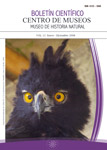Authors
Abstract
This epidemiologic study was carried out with the goal of identifying ethiological agents responsible of current diseases in Sylvilagus brasiliensis wild rabbit populations in “Los Nevados” Natural National Park. With a conservation medicine focus under the concept of “Ecologic Disease Triad” and through a “Factorial Analysis of Multiple Correspondences and the SPAD-WIN software the current relationship between symptoms and wounds observed was determined and analyzed. Ethiological agents were identified through histopathology, microbiology and parasitology tests, taking into account special environmental conditions that help the spread of epidemic break outs in this specie. The wild rabbits of this sample act as intermediate hostesses of Taenias sp. and Echinococcus sp. which cause massive infestations in epidemic dimension. Fester dermatitis was detected, which was caused by ectoparasites and bacteria such as Staphylococcus aureus, as well as pulmonary infections. These phenomena cause density and spatial movement changes in this specie. The nutritional state directly influenced the frequency and form of the illnesses. The type of interaction among the hostess, agent and environment alter the diseases’ manifestation that affect these rabbit populations in the studied areas.
References
ARITA, H. T., 1992., Introducción de especies animales exóticas, beneficios y costos. México (DF): Subsecretaría Forestal y de Fauna Silvestre, Secretaría de Agricultura y Recursos Hidráulicos, 47-55.
AYALA, M., E., 1952. Cunicultura Industrial: 200 pp. Salvat Eds. S.A.
BOWMAN, D., 1999. Georgi’s Parasitology for Veterinarians: 450 pp. 9ª ed. Saunders.
CLARENCE, M. F., 1996. Manual Merck de Veterinaria: 326 pp. 7a ed. Editora Roca. São Paulo.
COLMES, J. C., 1996a.- Parasites as tretas to biodiversity in shrinking ecosystems. J. Biodiv. Conserv., 5: 975-983.
____________, 1996b. Parasites, biodiversity and ecosystem stability. J. Biodiv. Conserv., 5: 953-962.
CONSEIL CANADIEN DE PROTECTION ANIMAUX, 1998. Manual Sobre Cuidado y Uso de los Animales de Experimentación. Canadá, Anexo 14 (1), (2da edición).
COPERRINDER, A., BOYD, R. J. & STUART. H. R., 1986. Food Habits. Inventory and monitoring of wildlife habitat. U.S. Dep. Inter. Bur. Land Management. Service Center. Denver: 858 pp.
DURANT, P., 1986. Relaciones filogenéticas y ecología del conejo de páramo andino. Monog., 6. CDCHT y Consejo de Publs. Universidad de los Andes. Mérida. Venezuela.
DURANT, P. & PÉREZ R., 1988. Distribución geográfica y ecológica de los conejos silvestres de Venezuela. El conejo de páramo y el conejo de monte. Monog., CDCHT-ULA. Mérida, Venezuela.
DURANT, P. & GUEVARA, M., 2000. Hábitat del conejo Venezolano Sylvilagus varinaensis (Lagomorpha: Leporidae). Rev. Ecol. Lat. Am., 7: (1- 2): 01-10.
GOOSEM, M., 1997. Internal Fragmentation: the effects of roads, higways, and powerline clearing son movements Ecology, mangement, and conservation of fragmentated comunities. The University of Chicago Press. (Ill.)
KUFNER, M., TAMBURINI, D., GIRAUDO, L. & BRIGUERA, V., 2005. Conservación de mastozoofauna en fragmentos de bosque chaqueño en la región de Mar Chiquita (Córdoba, Argentina). Ecología Aplicada, 4 (1-2): 53-58.
MAFFEI, L. CUÉLLAR, E. & NOSS A., 2002. Uso de trampas-cámara para la evaluación de mamíferos en el ecotono Chaco-Chiquitanía. Bolivia. Rev. Biol. Ecol., 11: 55-65.
MANABE, S. W. R., 1986. Reduction in summer soil wetness induced by an increase in atmospheric carbon dioxide. JSTOR., 232 (4750): 626-628.
MERCHANT, L. A. & PACKER R., 1980. Bacteriología y Virológica Veterinarias. 3a ed. Ed. Acribia, Zaragoza, España.
MINCHELLA, D. M., 1991. Parasitism cryptic determinant of animal comunita structure. J. Trenes Ecol. Evol., 250-254.
SCHINDLER, D. W., BEATY, K. G., FEE, E. J., CRUIKSHANK D. R., DEBRUYN, E. R., FINDLAY, D. L., LINSEY, G. A., SHEARER, J. A., & TURNER, M. A., 1990. Effects of Climatic Warming on Lakes of The Central Boreal Forest. JSTOR., 250, (4983): 967-970.
SAN MARTÍN, 1981. Salud y enfermedad: 73-77, La Prensa Médica Mexicana México, D.F.
VALERO, L. & DURANT, P., 2001. Análisis de la Dieta del Conejo de Páramo, S. brasiliensis meridensis Thomas, 1904 (Lagomorpha: Leporidae) en Mucubaji, Mérida, Venezuela. Rev. Ecol. Lat. Am., 8 (2): 1-13.

 PDF (Español)
PDF (Español)
 FLIP
FLIP


















